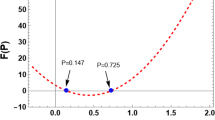Abstract
In this paper a methodology of mathematical description of the synthesis, storage and release of the neurotransmitter during the fast synaptic transport is presented. The proposed model is based on the initial and boundary value problem for a parabolic nonlinear partial differential equation (PDE). Presented approach enables to express space and time dependences in the process: rate of vesicular replenishment, gradients of vesicular concentration and, through the boundary conditions, the location of docking and release sites. The model should be a good starting point for future numerical simulations since it is based on thoroughly studied parabolic equation. In the article classical and variational formulation of the problem is presented and the unique solution is shown to exist. The model is referred to the model based on ordinary differential equations (ODEs), created by Aristizabal and Glavinovic (AG model). It is shown that, under some assumptions, AG model is a special case of the introduced one.
Similar content being viewed by others
References
Aristizabal F. and Glavinovic M.I. (2004). Simulation and parameter estimation of dynamics of synaptic depression. Biol. Cybern. 90: 3–18
Boyd I.A. and Martin A.R. (1956). The end-plate potential in mammalian muscle. J. Physiol. 132: 74–91
Chang S. and Popov S.V. (1999). Long-range signaling within growing neuritis mediated by neurotrophin-3. Neurobiology 96: 4095–4100
del Castillo J. and Katz B. (1954). Quantal components of the end-plate potential. J. Physiol. 124: 560–573
Evans, L.C.: Partial Differential Equations. American Mathematical Society, Providence (1998)
Friedman A. and Craciun G. (2005). A model of intracellular transport of particles in an axon. J. Math. Biol. 51: 217–246
von Gersdorff H., Vardi E., Matthews G. and Sterling P. (1996). Evidence that vesicles on the synaptic ribbon of retinal bipolar neurons can be rapidly released. Neuron 16: 1221–1227
Keener J. and Sneyd J. (1998). Mathematical Physiology. Springer, New York
Lenzi D. and von Gersdorff H. (2001). Structure suggests function: the case for synaptic ribbons as exocytotic nanomachines. Bioessays 23: 831–840
Lenzi D., Runyeon J.W., Crum J., Ellisman M.H. and Roberts W.M. (1999). Synaptic vesicle populations in saccular hair cells reconstructed by electron tomography. J. Neurosci. 19: 119–132
Magleby K.L. and Stevens C.F. (1972). A quantitative description of end-plate currents. J. Physiol. 223: 173–197
Morgans C.W. (2000). Neurotransmitter release at ribbon synapses in the retina. Immunol. Cell Biol. 78: 442–446
Oheim M., Loerke D., Stuhmer W. and Chow R.H. (1999). Multiple stimulation-dependent processes regulate the size of the releasable pool of vesicles. Eur. Biophys. J. 28: 91–101
Parsons T.D., Coorsen J.R., Horstmann H. and Almers W. (1995). Docked granules, the exocytic burst, and the need for ATP hydrolysis in endocrine cells. Neuron 15: 1085–1096
Parsons T.D. and Sterling P. (2003). Synaptic ribbon: conveyor belt or safety belt?. Neuron 37: 379–382
Squire L.R., Bloom F.E., McConnel S.K., Roberts J.L., Spitzer L.C. and Zigmond M.J. (2003). Fundamental Neuroscience. Academic, New York
Steyer J.A., Horstmann H. and Almers W. (1997). Transport, docking and exocytosis of single granules in live chromaffin cells. Nature 388: 474–478
Vitale M.L., Seward E.P. and Trifaró J.M. (1995). Chromaffin cell cortical actin network dynamics control the size of the release-ready vesicle pool and the initial rate of exocytosis. Neuron 14: 353–363
Wloka J. (1987). Partial Differential Equations. Cambridge University Press, New York
Zenisek D., Steyer J.A. and Almers W. (2000). Transport, capture and exocytosis of single synaptic vesicles at active zones. Nature 406: 849–854
Zucker R.S. and Regehr W.G. (2002). Short-term synaptic plasticity. Annu. Rev. Physiol. 64: 355–405
Author information
Authors and Affiliations
Corresponding author
Rights and permissions
About this article
Cite this article
Bielecki, A., Kalita, P. Model of neurotransmitter fast transport in axon terminal of presynaptic neuron. J. Math. Biol. 56, 559–576 (2008). https://doi.org/10.1007/s00285-007-0131-5
Received:
Revised:
Published:
Issue Date:
DOI: https://doi.org/10.1007/s00285-007-0131-5




